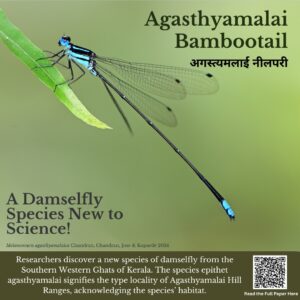Kerala/Pune, November 18, 2024 (TBB Bureau): In a groundbreaking discovery, a collaborative research team from MIT World Peace University (MIT-WPU), Pune, and Christ College, Kerala, has identified a new damselfly species in the pristine landscapes of the Western Ghats. The species, named the Agasthyamalai Bambootail, was discovered in Manjadininnavila, near the Peppara Wildlife Sanctuary in Kerala’s Thiruvananthapuram district.
Scientifically christened Melanoneura agasthyamalaica, the species pays homage to the Agasthyamalai landscape, a biodiversity hotspot that underscores India’s ecological richness. Led by Vivek Chandran of Christ College, the research team comprised Dr. Pankaj Koparde and Arajush Payra from MIT-WPU, Reji Chandran of the Society for Odonate Studies, and Dr. Subin K. Jose from Christ College.
 The Agasthyamalai Bambootail joins the genus Melanoneura as only the second known species, alongside its relative, the Malabar Bambootail (Melanoneura bilineata), found in the Coorg-Wayanad region. The new damselfly is remarkable for its bamboo-like cylindrical abdomen and distinctive appearance — a long black body adorned with vivid blue markings.
The Agasthyamalai Bambootail joins the genus Melanoneura as only the second known species, alongside its relative, the Malabar Bambootail (Melanoneura bilineata), found in the Coorg-Wayanad region. The new damselfly is remarkable for its bamboo-like cylindrical abdomen and distinctive appearance — a long black body adorned with vivid blue markings.
Significant genetic differences set this species apart. With over 7% genetic variation in the mitochondrial cytochrome oxidase-I gene, it distinguishes itself from its cousin in structural features such as the prothorax, anal appendages, and secondary genitalia.
The team’s exploration revealed the species thriving in streams and non-reserve ecosystems, including areas flowing into the Karamana River near home yards. Additional populations were recorded in the Ponmudi Hills and Bonacaud, all within the Agasthyamalai landscape, emphasizing the need to study biodiversity beyond protected forest zones.
“This discovery shines a light on the ecological significance of the Agasthyamalai region and the urgent need for conservation,” said lead researcher Vivek Chandran. He highlighted the species’ restricted habitat range and the growing threats to such delicate ecosystems.
Dr. Pankaj Koparde from MIT-WPU underscored the importance of non-reserve ecosystems, stating, “Conservation efforts must extend beyond protected forests to include surrounding landscapes that sustain vital biodiversity.”
The discovery reflects the commitment of Indian academic institutions to advancing ecological research and conservation. The collaborative efforts of MIT-WPU and Christ College not only add a critical species to India’s rich biodiversity but also serve as a clarion call for intensified conservation measures in one of the world’s most celebrated biodiversity hotspots, the Western Ghats.
As this damselfly’s discovery continues to capture the imagination of scientists and conservationists, it reminds us of the incredible yet fragile natural treasures that lie hidden in the heart of India’s landscapes.
 The Business Bytes
The Business Bytes